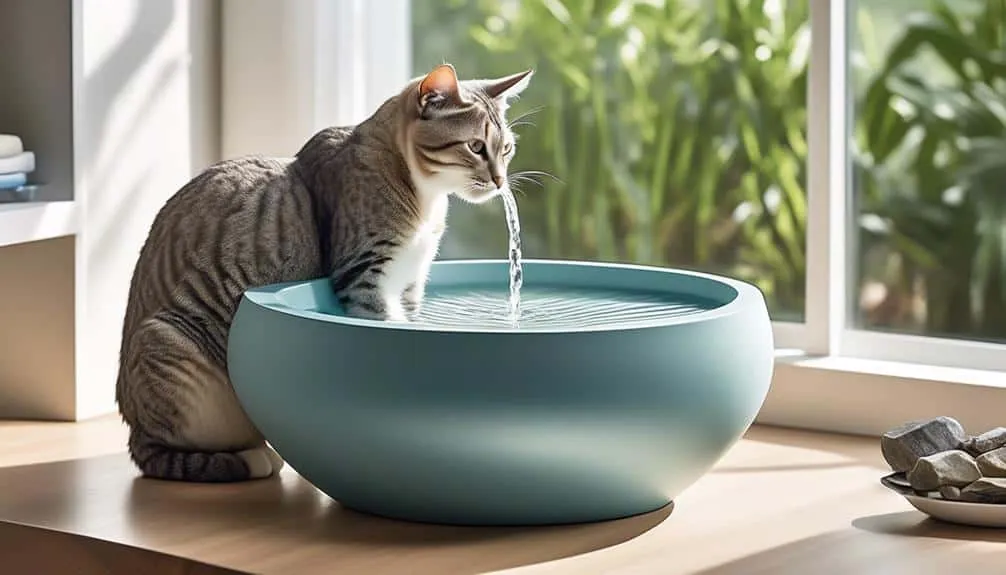The Best Fluffy Pancakes recipe you will fall in love with. Full of tips and tricks to help you make the best pancakes.

Are you tired of your cat's water bowl falling short of satisfying their thirst? It's time to unlock the secrets of the perfect quench.
In the battle between cat water bowls and fountains, which one will emerge as the ultimate winner? As you embark on this journey, prepare to uncover the hidden truths and surprising discoveries about these two options.
The answer may not be as straightforward as you think, but fear not – we'll guide you through every step of the way. So, are you ready to quench your curiosity and find the ideal water solution for your feline companion?
Key Takeaways
- There are various types of water bowls available for cats, including tall, deep bowls that may irritate their whiskers and plastic bowls that can harbor bacteria.
- Stainless steel bowls are the best choice as they are germ-resistant and easy to clean, but some cats may be spooked by the reflection.
- Bamboo bowls are environmentally friendly and have a non-slip bottom, while glass and ceramic bowls are easy to clean but can crack or chip easily.
- Water fountains provide constantly circulating water and a filter to keep it fresh and enticing for cats, but they are more expensive and require a power outlet.
Types of Water Bowls and Their Benefits
When it comes to choosing a water bowl for your cat, there are various types available, each with its own benefits and considerations.
Different materials for water bowls include plastic, stainless steel, glass, ceramic, and bamboo.
Plastic bowls may not be dishwasher safe and can harbor bacteria.
Stainless steel bowls are the most popular choice due to their durability and hygiene.
Glass and ceramic bowls are easy to clean but can crack or chip easily.
Bamboo bowls are environmentally friendly and have a non-slip bottom.
Tips for encouraging cats to drink more water include placing the water bowl in a quiet location, using a wide and shallow bowl to prevent whisker irritation, and changing the water daily to keep it fresh.
Advantages and Disadvantages of Water Bowls
Now let's explore the advantages and disadvantages of using water bowls for your cat's hydration needs.
Water bowls have several pros and cons. On the positive side, water bowls are cheap, easy to replace, and can be placed in multiple areas of the house. They're low maintenance, easy to monitor and refill, and come in various materials.
However, there are some downsides to using water bowls. Water in bowls can easily get stagnant and require thorough cleaning. Some cats don't enjoy standing water or the feeling of their whiskers touching the bowl. Additionally, water bowls may not be enticing for all cats.
It's important to consider these factors when deciding whether to use a water bowl or explore other options like water fountains for your cat's hydration needs.
Overview of Water Fountains
Water fountains provide a continuous flow of fresh and enticing water for your cat's hydration needs. They come in various sizes, shapes, designs, and styles, allowing you to choose the one that best suits your cat's preferences.
The continuous filtration and circulation in water fountains keep the water clean and appealing to cats. One of the main advantages of using a water fountain is that it ensures the water doesn't get stagnant, which can be a concern with regular water bowls.
Additionally, water fountains are ideal for cats that prefer drinking from running water or the tap. They require less frequent cleaning compared to water bowls.
However, it's important to note that water fountains can be more expensive than water bowls and need to be plugged in. When choosing a water fountain for your cat, consider factors such as size, noise level, ease of cleaning, and the type of filter it uses.
Benefits and Considerations of Water Fountains
To further explore the benefits and considerations of water fountains, let's delve into the advantages they offer in terms of providing fresh and enticing water for your cat's hydration needs.
Water fountains aren't only a convenient option for keeping your cat hydrated but also have several benefits. Firstly, water fountains are cost-effective in the long run compared to constantly replacing water bowls. They require less frequent cleaning and the filters only need to be replaced periodically.
Secondly, water fountains have a positive impact on a cat's water intake and hydration levels. The continuously circulating water and the appeal of flowing water can encourage cats to drink more. This is especially beneficial for cats who prefer drinking from running water or the tap.
Importance of Ensuring Your Cat Drinks Water
Ensuring that your cat stays properly hydrated is crucial for their overall health and well-being. Cats have a low thirst drive, which means they may not drink enough water to meet their hydration needs. This can lead to various health issues, including kidney problems and urinary tract infections.
To encourage your cat to drink more water, it's important to provide fresh and clean water at all times. Running water can be especially appealing to cats, as it mimics their natural instinct for flowing water. Consider using a water fountain, as it keeps the water circulating and fresh, making it more enticing for your cat to drink.
Conclusion
In the ultimate showdown between cat water bowls and fountains, the decision ultimately comes down to your feline friend's preferences and needs.
While water bowls offer a range of options with their various materials, water fountains provide the appeal of flowing water and filtration systems.
Whichever you choose, the key is ensuring your cat drinks enough water to maintain their overall health.
So, dive in and discover the perfect quench for your beloved feline companion, whether it be a traditional bowl or a modern fountain.








